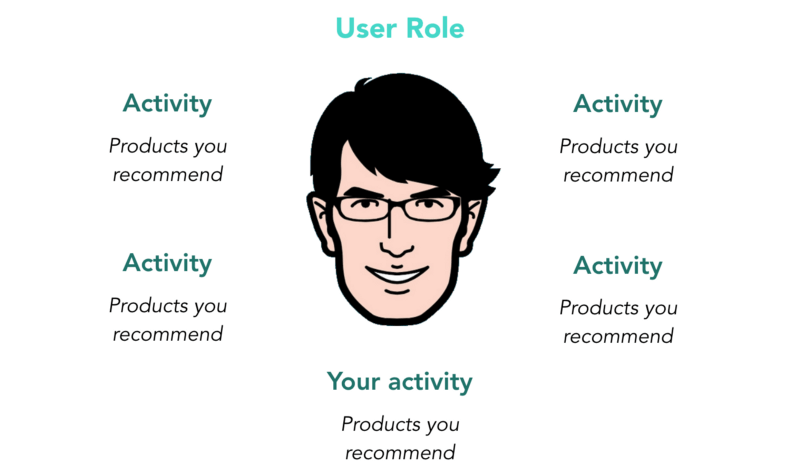Product Positioning: A Process for Startups
Written by Dave Bailey

Do you have a hard time getting your products to stand our? Here's a repeatable process you can use to help position your company and product in the market.
The following process clarifies your product’s positioning like no other I’ve found in 10 years of marketing . . . and a clear idea of your product’s positioning makes all the difference.
Learn new skills every week ->
Positioning is make or break
Positioning is a marketing strategy that aims to make a brand occupy a distinct position, relative to competing brands, in the mind of the customer. A typical positioning statement looks like this:
For __ (target segment) who __ (statement of need / opportunity). The __ (name of product) is a __ (product category) that __ (statement of core benefit; i.e. a compelling reason to buy). Unlike __, (competing alternative) our product __ (key point of difference).
A well-chosen positioning statement helps inspire better messaging, identify effective marketing channels and, of course, build better products. On the other hand, a poorly-chosen positioning statement all but guarantees failure, by cementing faulty customer assumptions.
Therein lies the rub. Most positioning statements are never seen by customers. At best, they are validated indirectly. Often, they are never tested at all.
So, if you haven’t tested your positioning statement, you’re betting the house on an incredibly risky game.
The accidental positioning process
A founder friend recently came to me with a marketing problem. After listening to the specifics, I recommended that he publish content that established his company as a thought leader in their industry.
The first article I suggested was one that highlighted other — non-competing — products that could also help their customers. As it turned out, writing this article profoundly changed the course of his company for the better.
Recommending other products to his audience clarified how the market was segmented, and the specific needs felt by that segment. His company completely overhauled their product’s positioning, communications and feature set, validating their position in the market.
How to write a product recommendations article
This is the process you can use to write a similar article for your customers. By the end, you’ll be able to craft a bulletproof positioning statement, gaining a deeper understanding of your target segment and the reason they’ll select your product over competitors’.
1) Identify your customer’s role
What role is your customer playing when they use your product? For example, when I use Trello to organise my product backlog, I’m playing the role of Product Manager.
Sometimes the customer plays multiple roles. Today, when I use Skyscanner to find cheap flights, the role I’m usually playing is ‘Traveller’, but in the past, I was playing the role of ‘Management Consultant’. If your customers play multiple roles, choose one role to focus on in your positioning statement — the role where you believe your product will be most valuable.
Take it in: You’ve just identified a key aspiration of your target user — to succeed in this role.
2) List out the major activities this role involves
What activities does your customer’s role encompass? For example, as a Product Manager, my activities include understanding users, analysing user data, managing a product backlog, supporting development workflow, and communicating with the team.
You’re aiming for a list of six to ten major activities, one (or at most two) of which your product or service addresses.
If your product addresses every single activity, you’ve defined the role too narrowly. For example, if your product is an email client, the role of ‘email reader’ is too narrow. Try to zoom out, and ask yourself what role is the ‘email reader’ playing. Remember, choose just one role for this exercise.
Take it in: Your customers have a lot going on in their lives and your product plays a relatively small part.
3) List out the products that address each activity
Which products would help your customer perform this activity better, faster or cheaper? You’ll find there is always a spectrum of products to help customers in each activity.
As a Product Manager who needs to support development workflow, products I find useful include: Post-its and a whiteboard; Google Sheets; Trello; Jira; and Pivotal Tracker.
Don’t be afraid of researching areas unrelated to your product. It’s an opportunity to discover the ways other companies are addressing your target audience.
However, if you find your product is the only one listed under a particular activity, this is a red flag. Ask yourself these questions: how do people perform this activity without your product? What happens if they don’t do this activity at all? Is this really a stand-alone activity, or is it part of another activity?
Take it in: Look at how many other companies are competing for your user’s attention.
Learn new skills every week ->
4) Decide which products would you recommend for which type of customer?
How would you advise a customer to choose the right product for their needs? How would your customers make recommendations to others? Go and ask them which solution they’d recommend for each activity, and why.
To illustrate, here’s how I’d recommend Product Managers choose the right product to support their development workflow:
- If you’re part of a small, co-located team, creating a physical Scrum board with Post-it notes is extremely easy and has the advantage that it’s always visible to everyone on the team.
- If your team often works outside the office, Trello is a free, online alternative to a physical Scrum board. It allows you to create an online Scrum board with tools that help you collaborate on tasks like activity feeds and checklists.
- Trello boards often become too cumbersome for larger projects, so if you’re part of a large team (10+ people), Jira offers backlog analysis and product roadmapping to keep projects organised.
Notice the ‘if’ statements. I naturally segmented the customers around a small set of criteria — the size of the development team, and whether they are co-located or not. These dimensions determine the different needs those customers have.
Hopefully, the positioning statement above is now much clearer. The target segment isn’t everyone that performs this role . . . it’s based on the same criteria as your recommendations. Their need is specific to them, not some generic need for that activity.
When you come to recommend within a chosen activity, what are your ‘if’ statements? Are they similar to other activities? Which segments are you not competing for? Great positioning requires you to choose who isn’t your customer.
Take it in: Only a few dimensions actually affect how customers position a product in their heads.
5) Write your positioning statement as a product recommendation
At this point, you can write your positioning statement in the following format:
For Product Managers on small, distributed teams that need to support and collaborate with their development team, I’d recommend Trello, an online workflow tool that allows teams to create online Scrum boards. Unlike other online workflow tools, Trello is free, easy to use, and very flexible.
You want to be as concise and specific as possible. Remember, you aren’t positioning for the whole world, just for the user role you believe your product adds the most value to, as you defined it in Step 1.
6) Create a long-form article with this research
You’ve identified the activities your customer performs in their role and the products that can best help them. Now it’s time to share your recommendations with the world.

Choose a title that explicitly identifies the role your users are playing. For Product Managers, the title might be:
- ‘Top 39 products every Product Manager should be using’
- ‘How technology can make you a better Product Manager’
- ‘Essential products for any serious Product Manager’
Structure the article around the key activities and discuss your recommendations for each one. You can make it personal or formal, depending on what you think is easiest to read, and who your audience is likely to be. I’d suggest including your product category early in the piece, to maximise the number of readers exposed to it.
At the bottom of the article, ask for feedback, leave your business email address, and make it clear which company you work for.
Take it in: You’ve subtly shared your positioning with the world.
7) Promote the article and receive feedback
This is where the tire hits the road. Your goal is to get as many eyes on this content as possible, to learn where it can be improved.
Here are just a few things you can do to get exposure:
- Share it early with your close network, e.g., your team, friends, and early customers.
- Publish on your personal or company blog, and then republish on Medium, LinkedIn, and Quora, with alternative titles.
- Promote it in relevant online groups on Reddit, Facebook, and LinkedIn.
- Allow journalists who target your customers to republish it, with attribution.
- Ask the non-competitive products that you’ve recommended to share it with their audience — you could even suggest a partnership.
Every step of the way, absorb reader comments and update the content accordingly. Are there products you’ve missed out? Are there any objections to your recommendations? Have you neglected any activities? Make it easy for people to give you feedback and thank them for reading. It’s very likely that people in your target audience will read it, so you may even win some new customers.
Take it in: Feedback on this article will help you iterate your positioning statement.
Positioning is a recommendation in disguise
I’ve used this process several times, and each time it reveals new insights and a deeper understanding of the target market. It can be used for any product, in any industry, and it works for mature products just as well as it does for new product ideas.
How long it takes to complete depends on how much you already know about your customers and how quickly you can write. I estimate it’ll take somewhere between one and three days to do a good job, but it can move your understanding forward by months, so it’s an excellent use of time.
If you decide to try it out, share your article below. If you browse the articles of others, share any feedback you have for them. Feedback is, after all, how we improve.
Continue reading about product competition:
- Get your exciting new product off the ground by implementing great marketing strategies.
- At the tail end of developing your new product? Ensure that you answer key ‘market my product' questions to achieve market fit.
- Whether you're working on a business or product idea, you'll need to master how to write better product descriptions.
Originally published Feb 22, 2019, last updated Jul 27, 2023
Learn a new skill every week
Subscribe to my weekly newsletter and learn new skills and mental frameworks that make startup life easier.
Unsubscribe any time.





